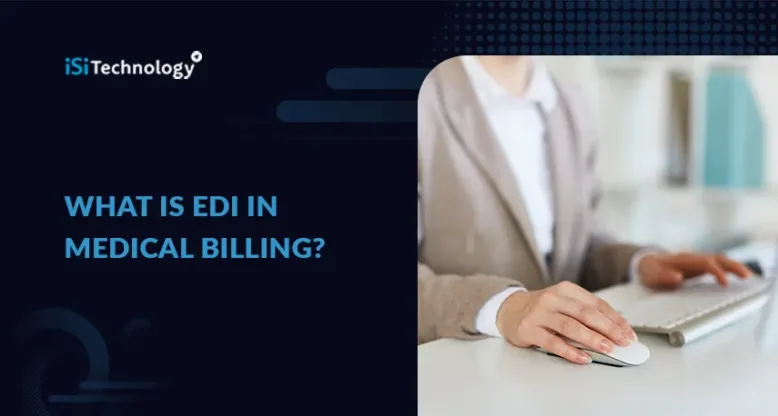What is EDI in Medical Billing?

Electronic Data Interchange (EDI) is the electronic exchange of business information. Data is transferred from one computer to another. It has become the standard among business partners and collaborators in the digital age.
With EDI, transactions can be completed with little to no physical paperwork.
Understanding Electronic Data Interchange
EDI streamlines traditional business transactions. Businesses used to send one another documents through postal mail and fax machines. Today’s wave of new workers may not even know what a fax machine is or how to use it.
Postal mail slows down transactions as one business has to wait for important documents to arrive. Sending them via fax is significantly faster, but the process can be troublesome.
Communication has become better and faster in the digital age. And while business transactions can be completed through email, EDI has emerged as the best option.
With EDI, all transactions and data exchanges are completed from one computer to the next, with little human intervention. It is much faster with significantly less scope for mistakes.
What are the benefits of EDI?
- Fast processing – All information is available within seconds or just a few clicks.
- Improved relationships between business entities – With faster transactions, businesses are paid more quickly, too.
- Fewer mistakes – Data exchange is less prone to human error. If there are mistakes, they are easier to correct.
- Reduced costs – EDI entails using software for efficiency, and the long-run cost makes it a worthy investment. There is no need to stock paper, folders, printer ink, etc.
It’s also worth noting that mountains of paperwork are a fire hazard, and voluminous documents take up a lot of space.
What is EDI in Healthcare?
EDI is the latest modern trend in healthcare. After all, every step of the process must be recorded.
For example, a patient visits a medical facility for a routine medical checkup. The receptionist will register the person’s name and personal details. The patient will then be handed off to medical personnel to get their vital signs.
Next, the patient talks to the doctor, who will conduct a physical checkup and record their findings and observations. The doctor may prescribe labs, medication, vitamins, or other treatment options.
Then, the patient heads to the pharmacy to purchase the prescribed medication. And finally, they go to the billing department for invoicing. The billing division will identify the payer for the checkup, whether the patient should pay in cash or hand everything off to private or government insurance.
Throughout the entire process, various records will be created:
- Personal information upon registration
- Vital signs
- Doctor’s report and findings
- Prescribed medication and vitamins
- Invoice
All of this information is critical for the patient’s overall experience and treatment. When they visit the medical facility again, their records will be pulled up to create a holistic and comprehensive plan for their health moving forward.
Medical billing software will be used to collate every piece of information obtained from the patient’s visit.
With EDI, every report is directly recorded in the system. Every report will support insurance claims. The medical facility will then send an invoice to payers and insurers through EDI.
Since information exchange is faster, verification is quick, and the rework process can be raised immediately. Payers and insurance providers can immediately approve or deny coverage.
With EDI, errors are spotted promptly, giving patients more time to correct the mistake and appeal the decision.
Benefits of EDI in Medical Billing
Modern transactions offer various benefits. Let’s take a look at the billing process.
What is EDI in billing? It refers to the payment communication and transaction between entities with EDI infrastructure.
In the case of medical billing, the healthcare facility and insurance providers must have EDI systems to reap its many benefits:
Fast
EDI enables fast transactions. Since all records are done through efficient software like ISI Technology, billing details are immediately available. Because of that, analysis is done promptly. All steps in the process—invoicing, verification, and payment—are completed without delay.
Efficient
Fewer errors are reported with EDI, which leads to efficiency. In case of mistakes, they can be revised immediately within the system.
Quick payouts mean efficient medical service, too. Payments are the lifeblood of any medical facility.
Cost Efficient
The one-time payment for EDI infrastructure can be expensive, but the rewards are forever. Plus, there is no need to buy materials for physical documentation, as everything will be done within a digital system.
EDI Standards and Formats in Medical Billing
Healthcare software must adhere to national standards, including the following:
- HIPAA – The Health Insurance Portability and Accountability Act of 1996 outlines the standards for the protection of patient health information.
- ANSI – The American National Standards Institute is a private, non-profit organization that sets the guidelines for inter-industry electronic exchange.
These standards ensure EDI is safe in terms of information exchange and all data remains protected.
EDI involves a standard format, so every machine receiving the communication or transaction can readily understand and interpret the content.
These formats are the most commonly used:
- Codes
- Identification values
- Message designs
- Syntax
Future Trends and Innovations in EDI for Medical Billing

EDI is slowly becoming the standard in medical billing. In no time, all medical facilities will have the structure for easy exchange of data.
Here are the other trends that some institutions are already leveraging to adapt to the ever-changing modern times:
ePCR System
Electronic patient care reporting is another paperless system that has become popular in the healthcare industry. It can be used in tandem with EDI when a patient gets a medical checkup. The system ensures legible and accurate reporting of all patient care information.
Blockchain Technology
Many people and institutions are drawn to cryptocurrency because blockchain technology promises secure and private transactions. These are similar criteria patients want in a medical records system.
AI
Would you want a robot to treat you? It may very well be the case in the future. For now, some institutions have leveraged artificial intelligence in diagnosing patients and recommending treatments.
Conclusion
The EDI meaning in medical billing is efficiency. Leveraging EDI means faster transactions and payouts, which will benefit all entities concerned. EDI follows mandated standards and formats and works seamlessly with all facilities’ medical billing software.
ISI Technology is behind many types of software used in healthcare. EDI with ISI Technology software will ensure your medical facility operates efficiently.
